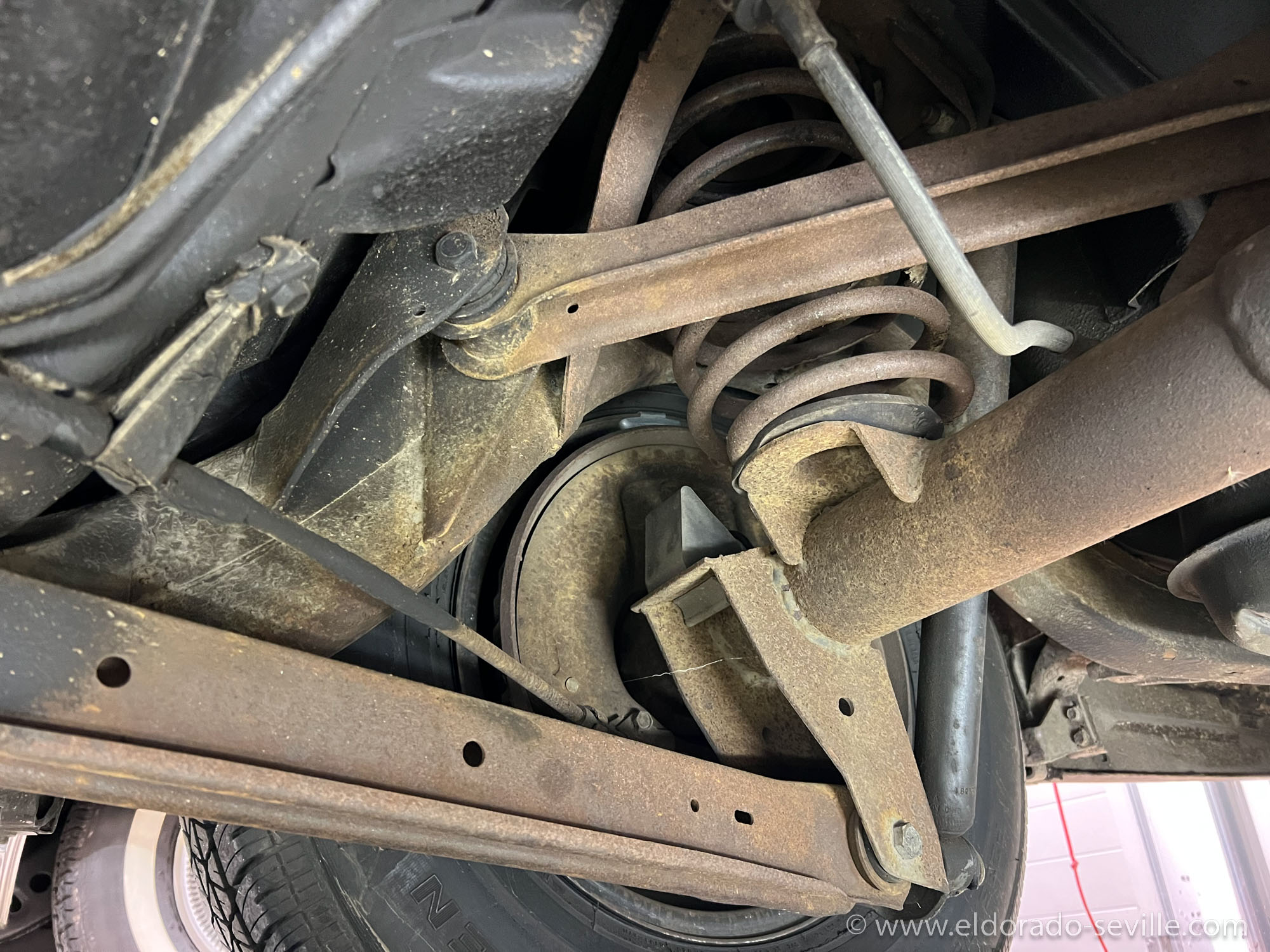THE 1966 UNDERCARRIAGE PROJECT - LONG POST!
VIDEO RECAP
I did not plan to do a video about the restoration, but here is a short collage of some footage I had: (on youtube you can watch it in 4k HDR
This is a short video showing what was done
BEFORE
Some "BEFORE" pictures showing how the car looked before I started working on it.
AFTER
This is how it looks now - after all the work I did. Click to see the full report.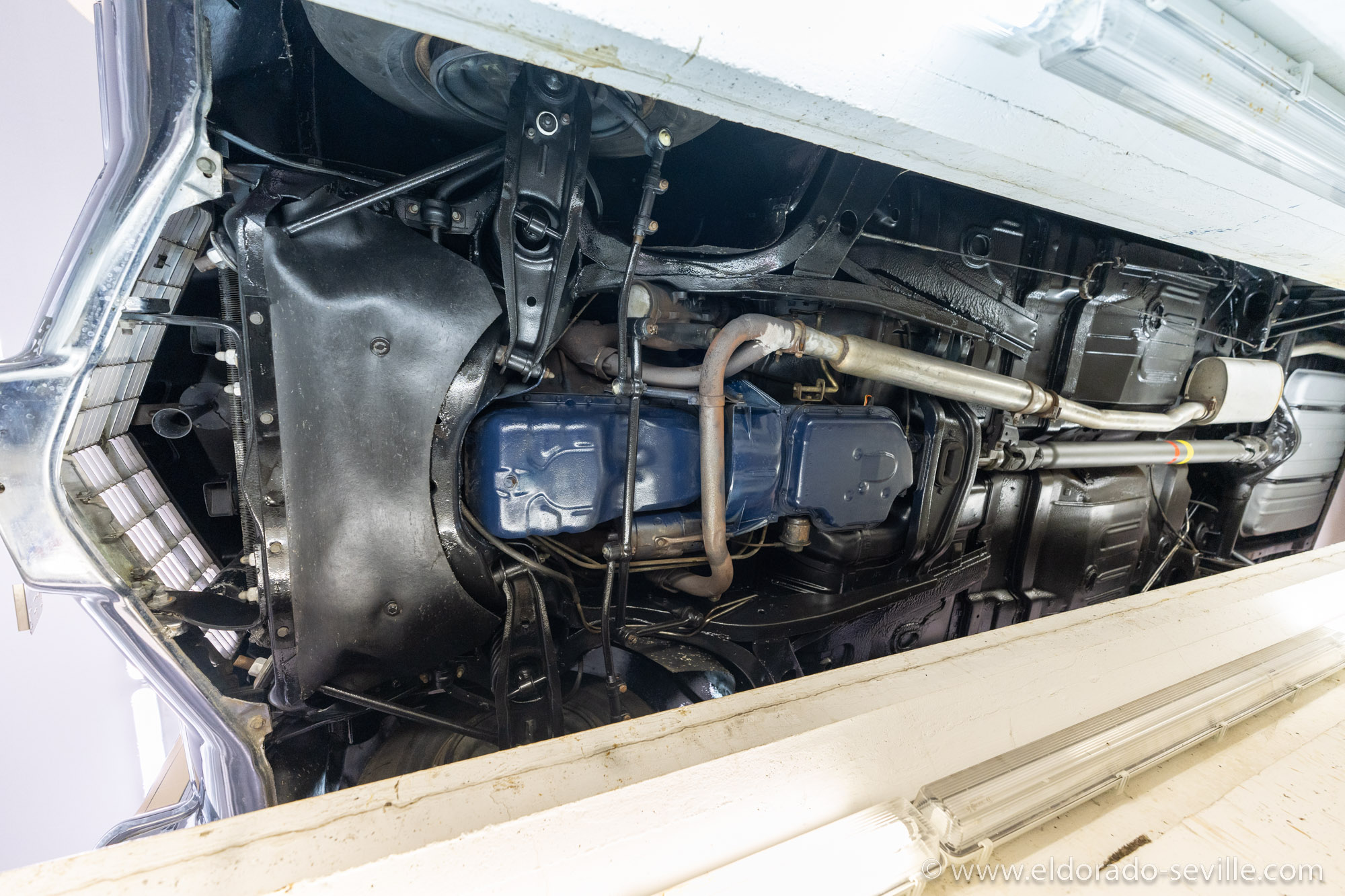
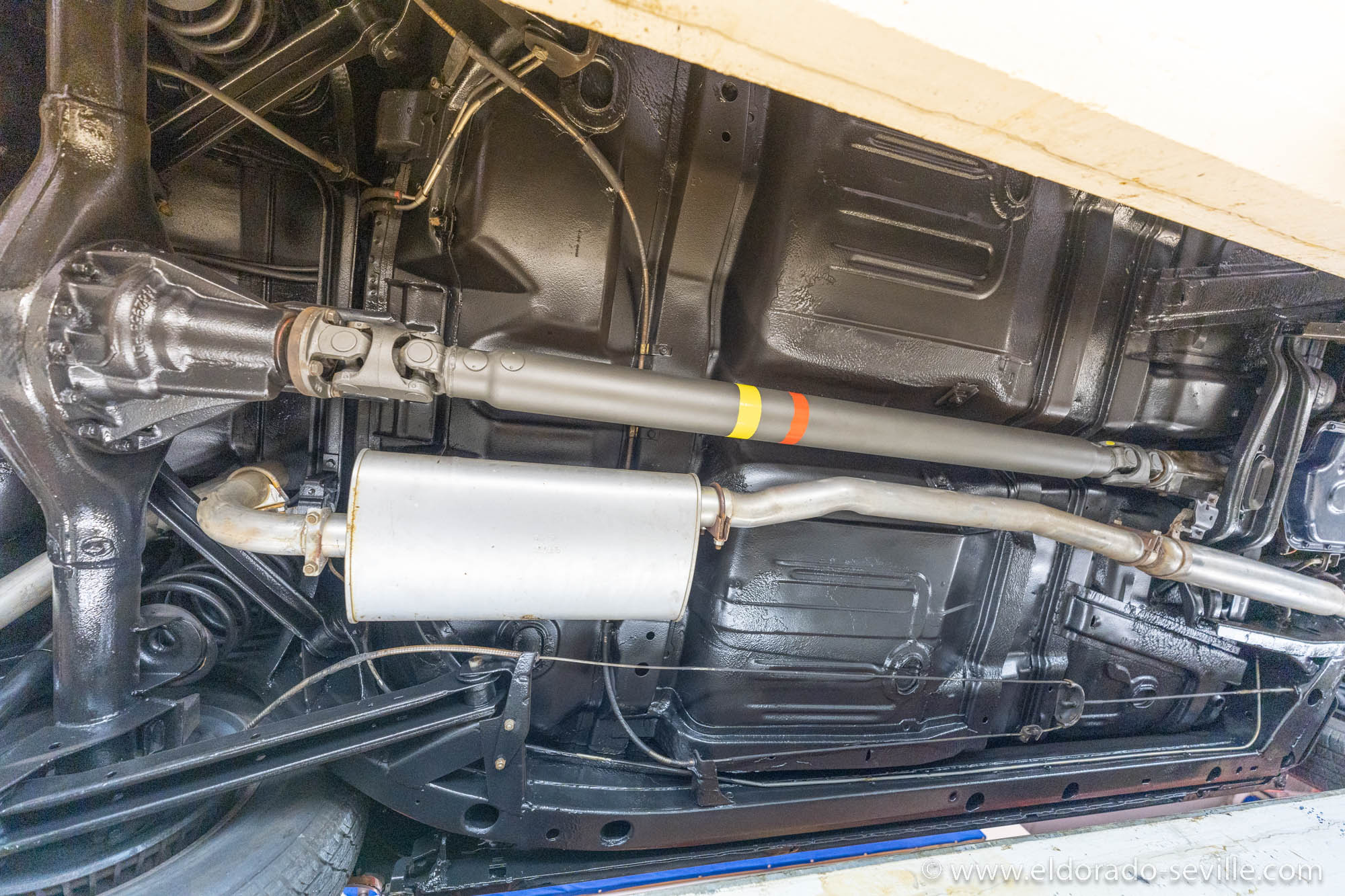
READ MORE...
1966 UNDERCARRIAGE CLEAN UP PROJECT
To make the car perfect again I will also dry ice blast the undercarriage and totally clean it up like I did on my 74 and the Roadmaster to preserve it as good as possible.
Today I started to brush some of the surface rust away. After that I will apply some rust remover.
I took some "before" pictures and a video.

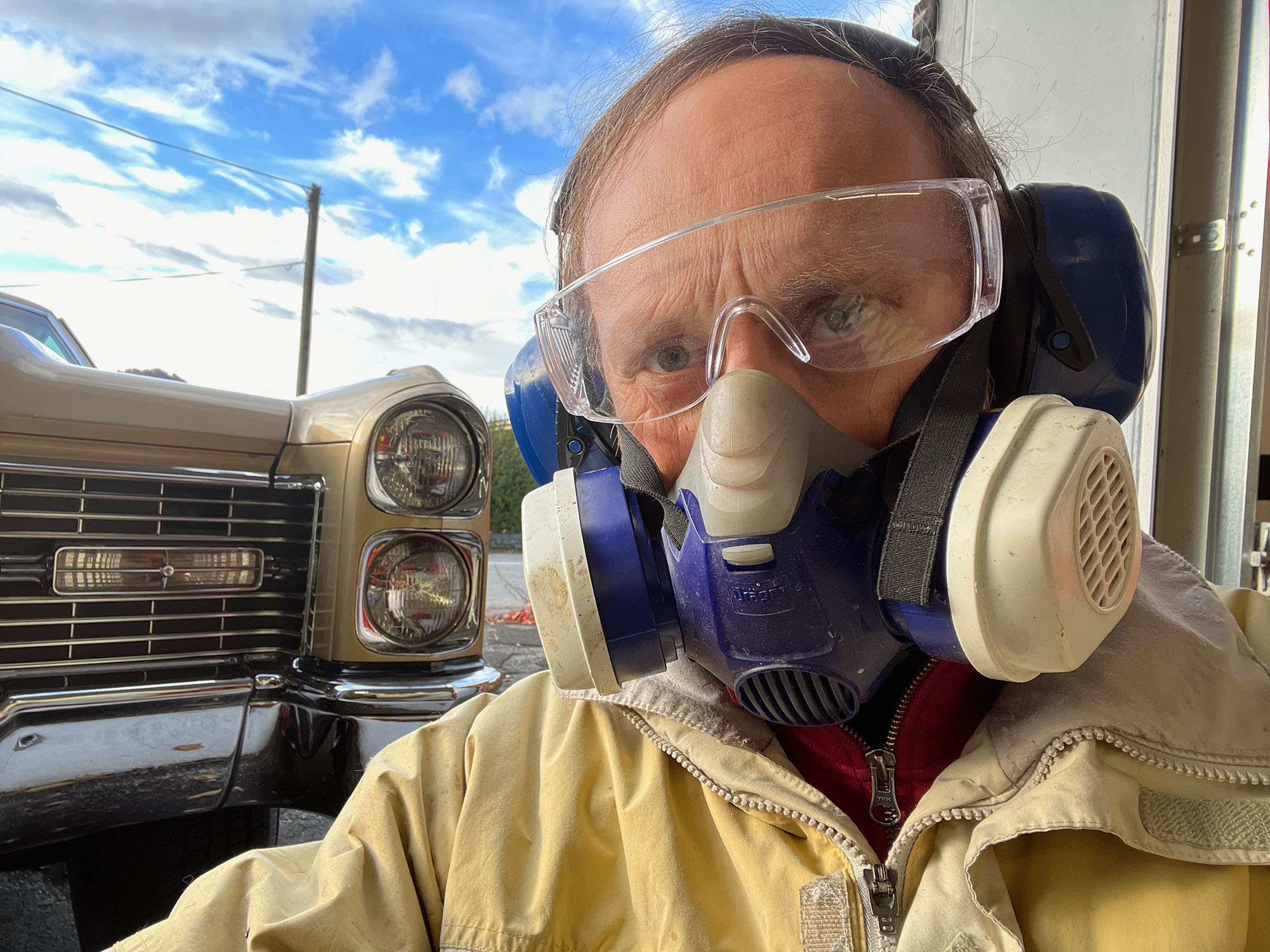
It will be a long and dirty job…
CLEANING THE UNDERCARRIAGE OF THE "NEW" 1996 BUICK ROADMASTER
This is how the car looked like after dry ice cleaning.
READ MORE...REMOVING RUST FROM THE UNDERCARRIAGE WITH RUST REMOVING LIQUID
I´m using a german product called "Rostio" - it's a concentrate used for de-rusting fuel tanks. You have to mix it with hot water. I have also heard great things about Evapo Rust.
I let my system run for days until all the surface rust was gone. The advantage is that the liquid can now get everywhere and should remove the last little piece of rust.
You will be surprised how well this works. This area now looks like a new car. There is not the slightest trace of rust to be found after 12 hours of spraying the car.
After spraying it with the rust remover you then have to flush it with water thoroughly and then dry it properly to avoid flash rust.
I also used various wire brushes and other abrasive materials to remove rust and strip bad paint.
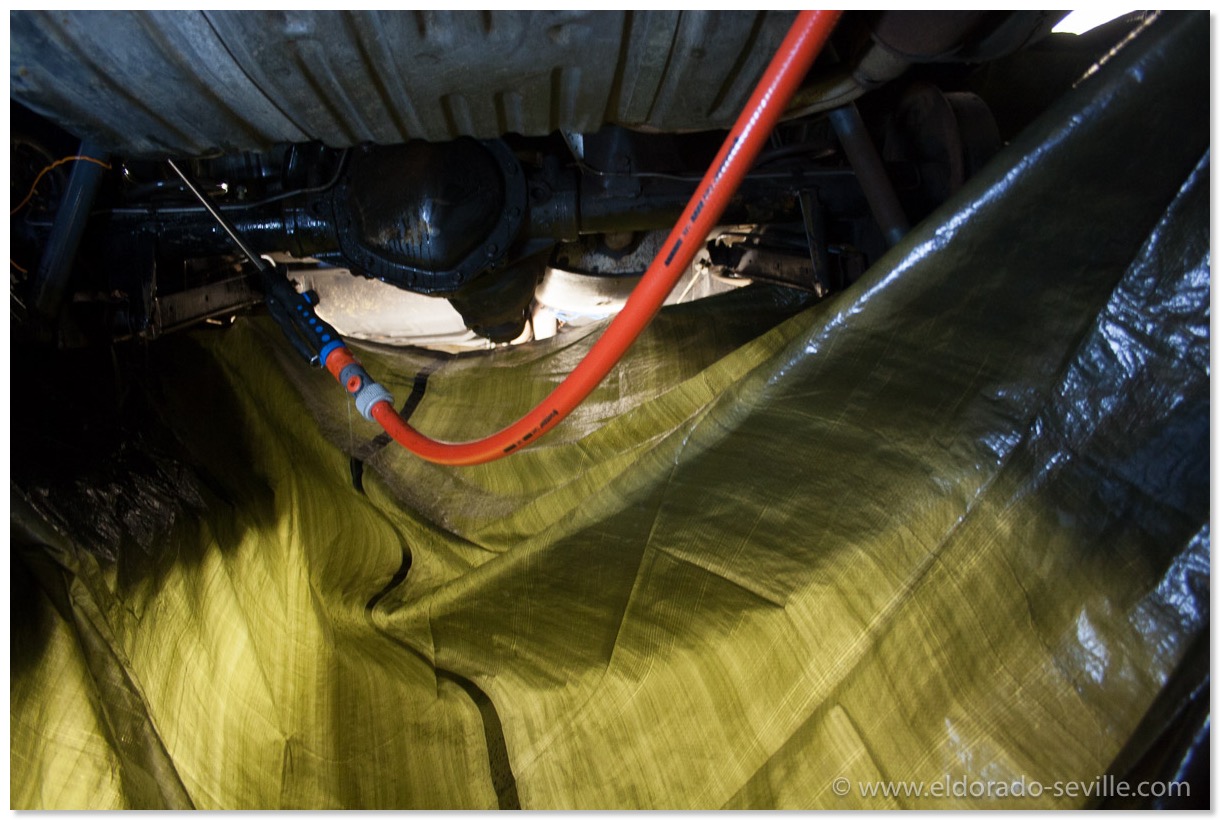
I simply used a garden hose and shower to spray the rust remover on.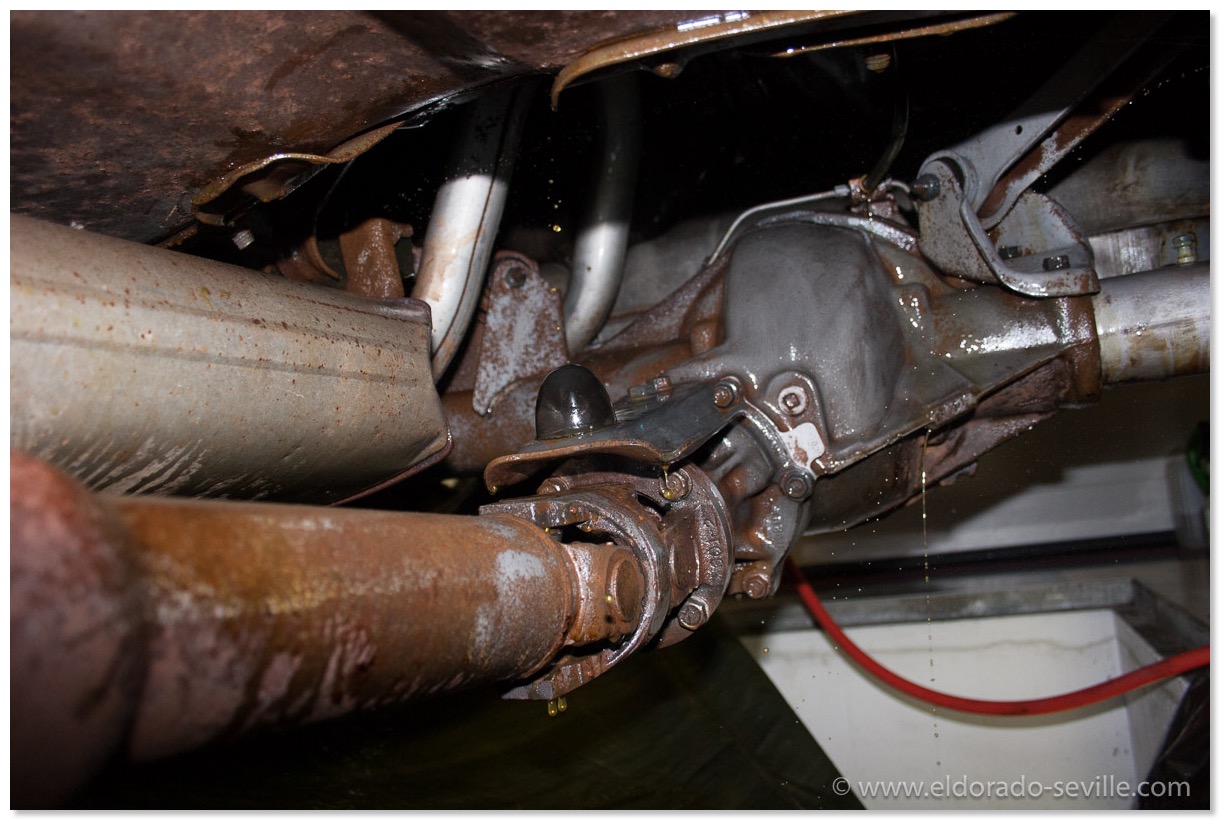
As you can see it only leaves rust free metal behind - I always let it run for 2 - 12 hours - depending on the amount of rust that had to be removed.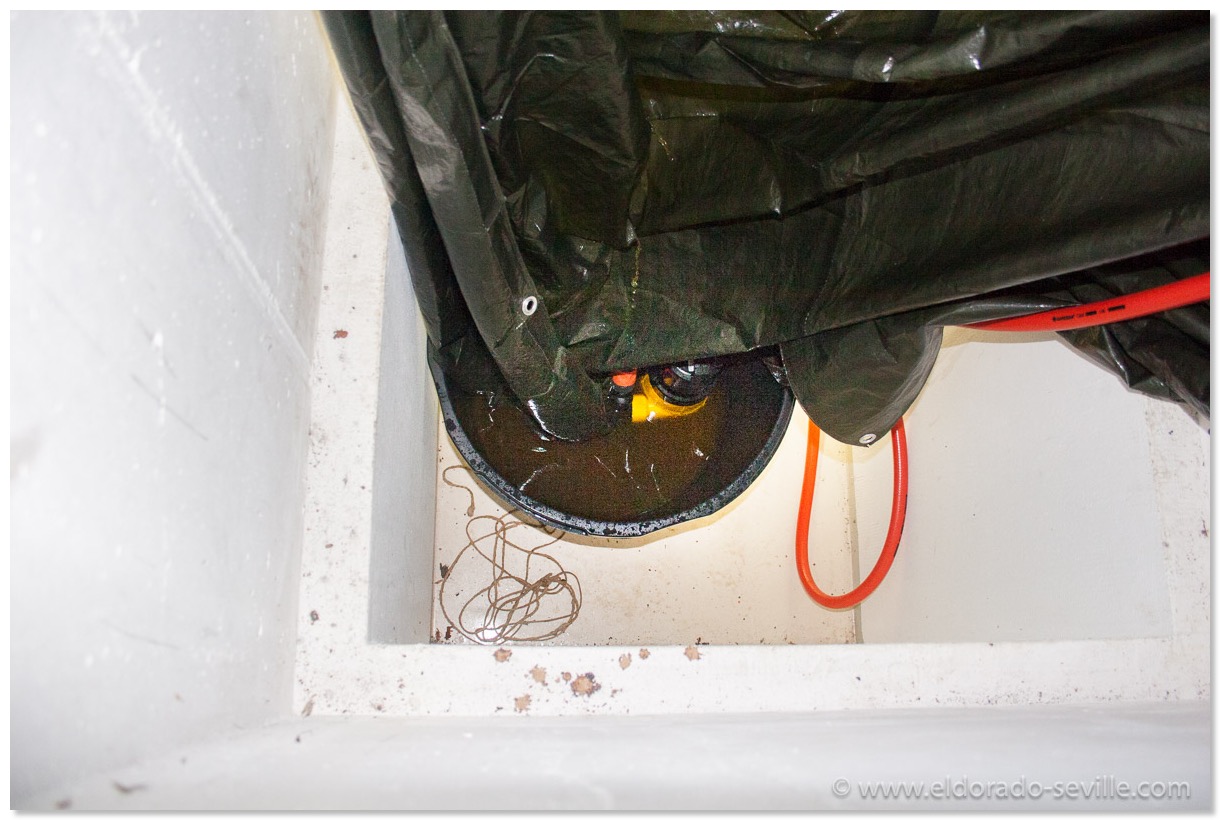
The liquid is collecting in the big bucket where I put the pump in to recirculate it.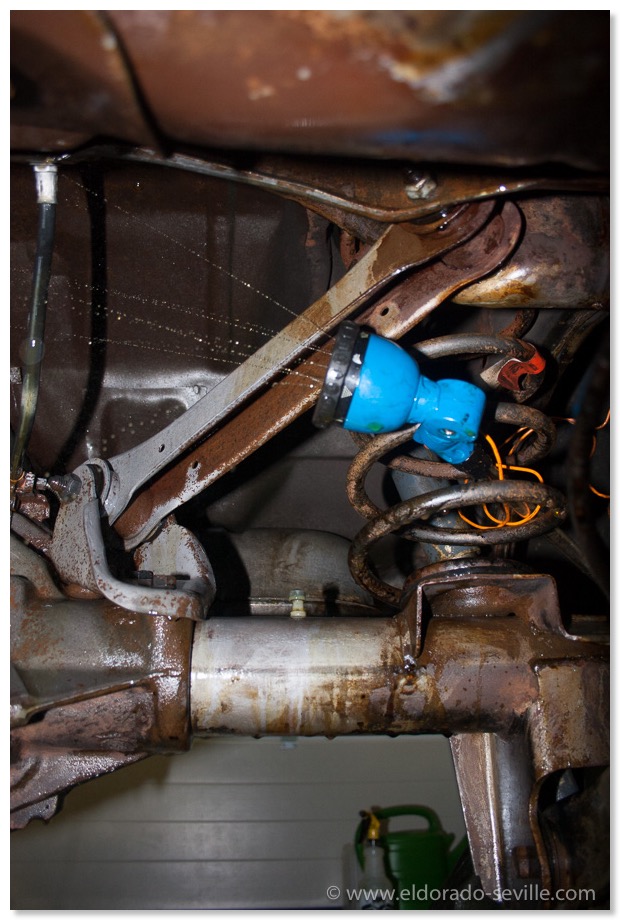
You can spray the liquid everywhere
A "before" picture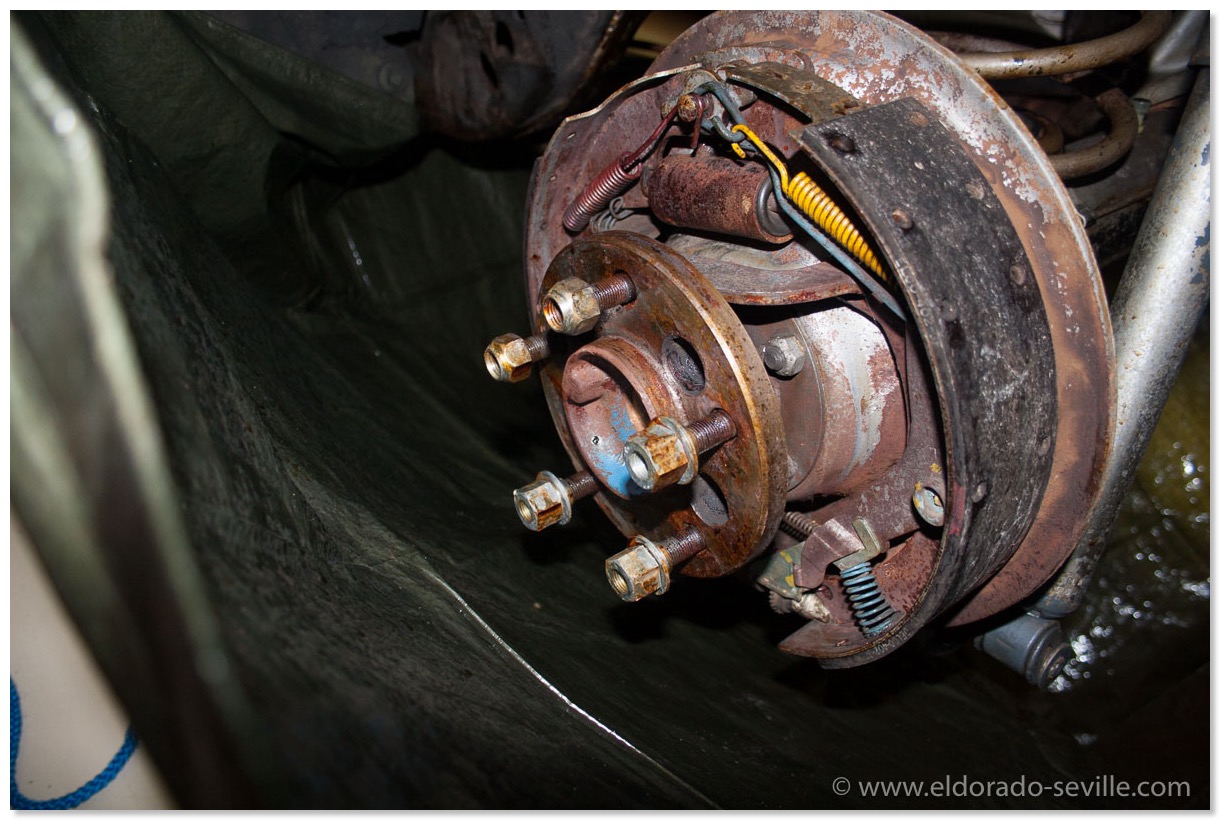
You can also remove the rust from the brakes without disassembling them. A before picture
After cleaning - the brake cylinder developed flash rust immediately again.
As you can see - the rust is gone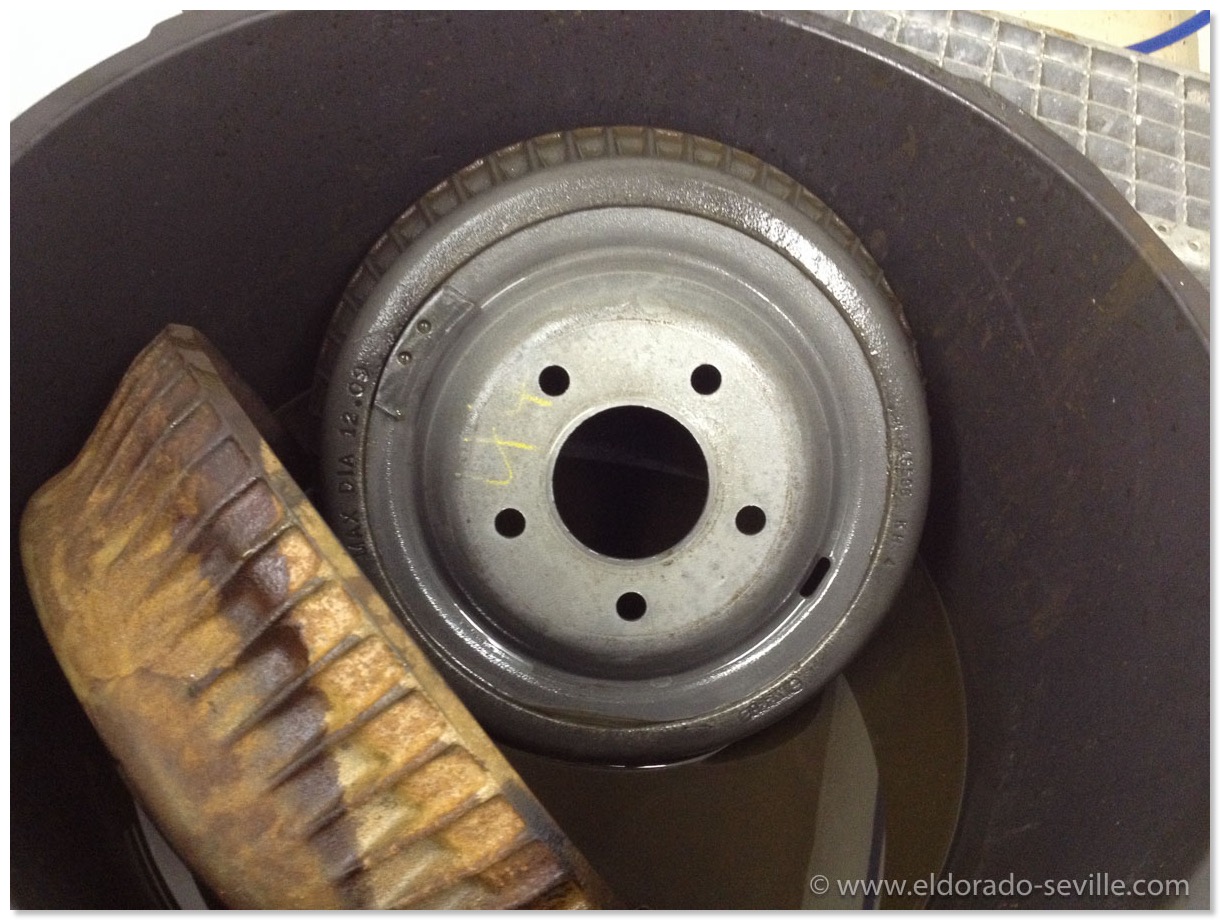
The liquid also works great on brake drums - the original factory markings were still there.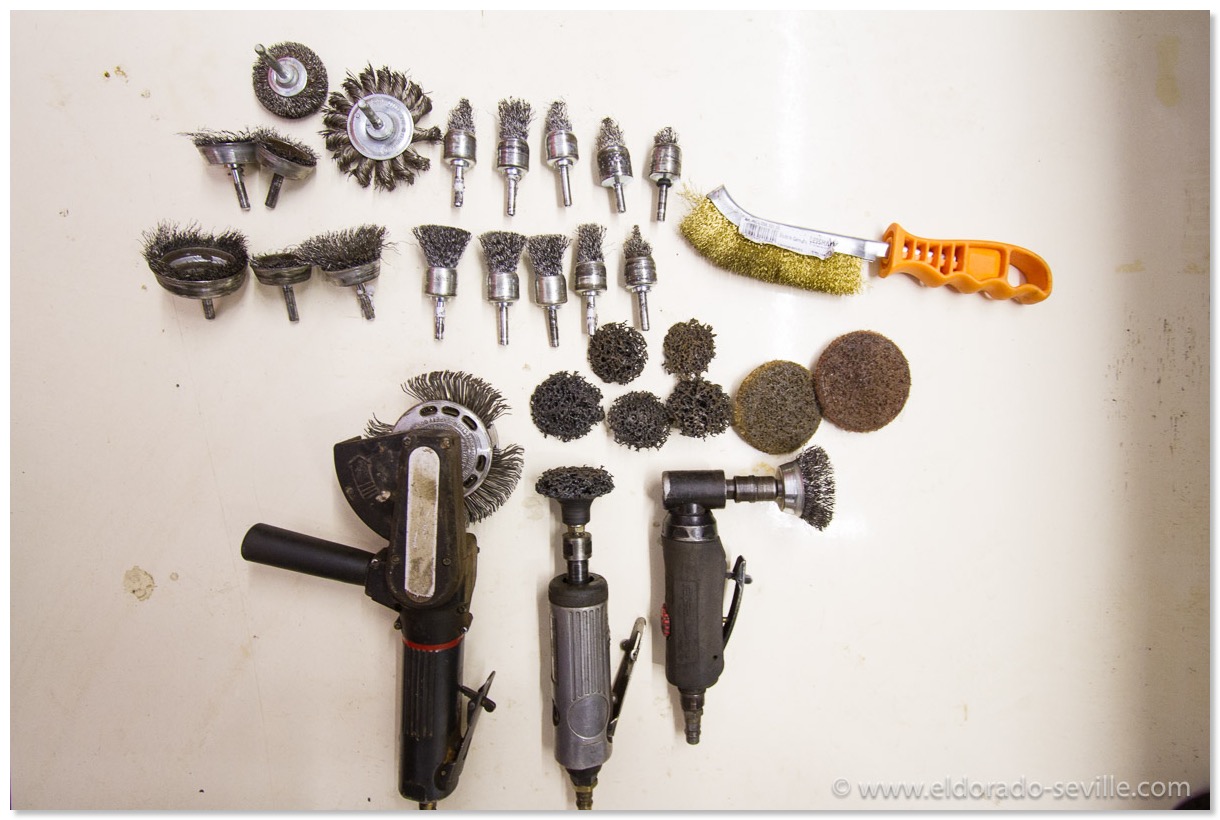
Cleaned the fuel tank with the wire brush and painted it afterwards with tank paint from Eastwood
Cleaned the wheelhousings as well - stripped all the paint in there as well.
≈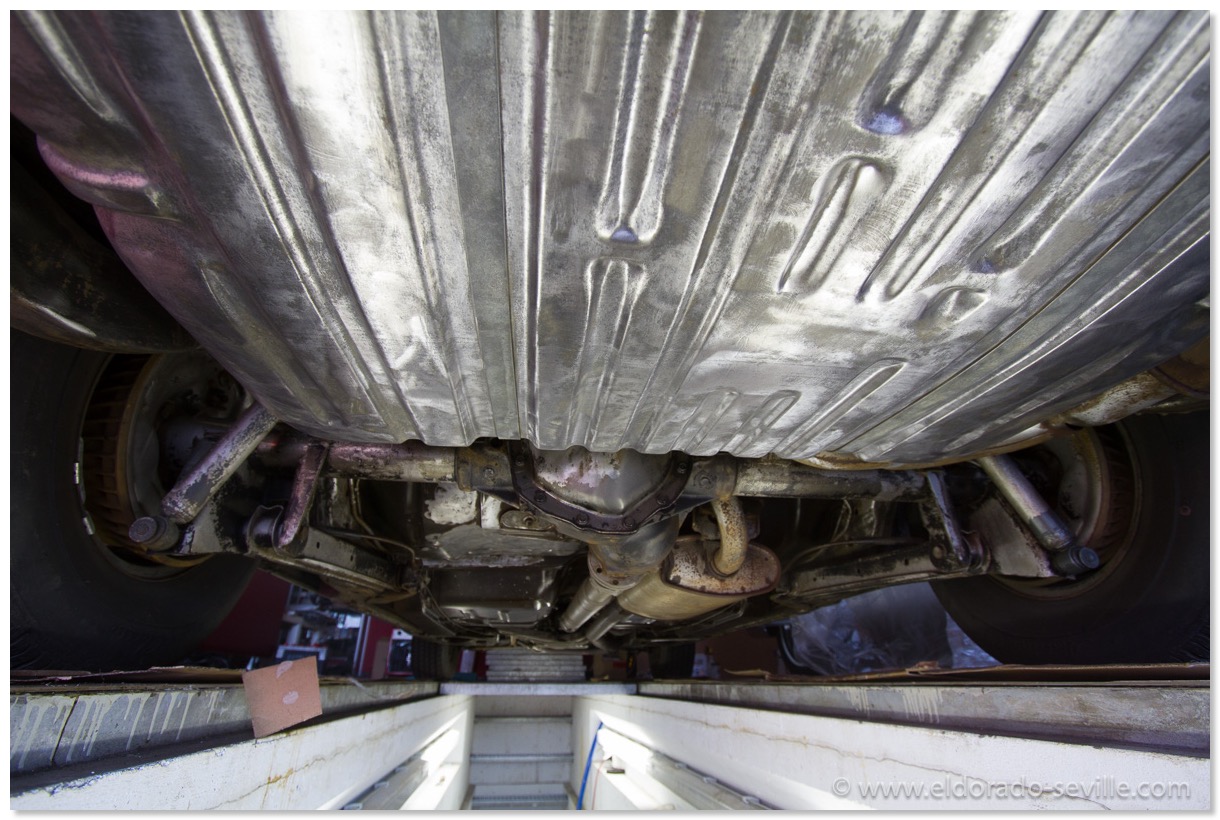
Cleaned the fuel tank with the wire brush and painted it afterwards with tank paint from Eastwood
THE 1974 UNDERCARRIAGE PROJECT IS FINISHED
I had some really bad luck with non sticking paint, undercoating reacting with the paint and shops not doing their job right…
The goal of this project was to remove all the surface rust, clean everything up and paint it in the correct colors again. For the ultimate, invisible protection I applied transparent undercoating from "Timemax" and transparent stone guard to the wheel housings. It was very important for me that the car looks as original and as perfect from the underside as the rest of it.
You can read reports about what I had to do by clicking here. You can also see all the restoration pictures in this gallery.
The undercarriage restoration project involved the following things:
- Removed some of the surface rust with rust remover gel.
- Had the undercarriage dry ice blasted and cleaned
- Removed all the surface rust with rust remover gel and liquid
- Cleaned the undercarriage with wire brush to strip bad paint down to bare metal
- Fully detailed the drive shaft
- Repainted the brake drums and fully detailed them with original factory markings.
- Had the rust free undercarriage painted in a paint shop in original black and brown with epoxy paints.
- Had the edges of the lower body parts painted as well in Persian Lime
- Found out that the new paint on undercarriage did not stick…
- Removed all the paint again with sandblasting and dry ice cleaning
- Repainted the undercarriage in the correct colors once again in the paint shop
- Applied transparent undercoating
- Applied transparent stone guard to wheel-housings
- The stone guard coating reacted with paint underneath
- Had another shop remove the paint from the wheel-housings again, as I did not want to do it myself for another time.
- This shop repainted the wheel housings and coated them with transparent undercoating and stone guard once again.
- I was not satisfied with their work so they had to re-do it.
- They sandblasted the wheel housings once again to get everything off to bare metal to be able to start all over once again.
- The restoration shop repainted the wheel housings and coated them with transparent undercoating and stone guard for the third time.
- I finally was satisfied with their work and took over again to detail all the splash guards and put everything back together.
- De-rusted the inner sides of the fender skirts and repainted them.
Other things I did on the 74 during this project:
- Repaired seat back release (3 times)
- Repaired the transmission shift dial indicator which was stuck in “L“ position.
- Replaced some of the plastic headlight adjusting parts which were broken.
- Fabricated license plate holders for Austrian plates.
- Repaired front ashtray mechanism which was stuck.
- Fixed loose left outer rear view mirror.
- Fixed a hole in the exhaust. (Temporary fix before I will replace the still original system which was installed in 1974)
- Replaced numerous burnt bulbs inside and outside of the car.
- Replaced AC compressor as bearing and clutch was shot.
- Repaired clock .
- Repaired radio.
- Replaced all speakers.
- Replaced heater core.
- Replaced front center bumper ends.
- Adjusted grill which was misaligned by the factory.
- Restored battery tray.
- Adjusted doors as they did not close well.
- Repaired door striker on passenger side.
- Replaced door bumper rubber.
- Installed new reproduction - correct heater hoses.
- Flushed cooling system.
- Changed oil.
- Changed shocks front and back.
- Changed stabilizer link and rubber.
- Replaced incorrect lug nuts.
- Changed lighting system to Austrian standards to get it road legal for the inspection.
- Replaced hood ornament.
- Replaced panel in dash.
- Sandblasted and repainted valve covers.
- Repaired washer fluid sensor.
- Replaced antenna.
- Fully detailed the paint and interior.
- Polished the windshield with glass polish.
- Painted oil pans.
- Painted fuel tank.
- Touched up some small stone chips
- Perfectly removed dents on the roof which happened during shipping of the car from the USA to Europe
- Tuned carburetor to factory specs
I´m sure that I have already forgotten some details - unfortunately I often forgot to take pictures, so I cant document everything with pictures…
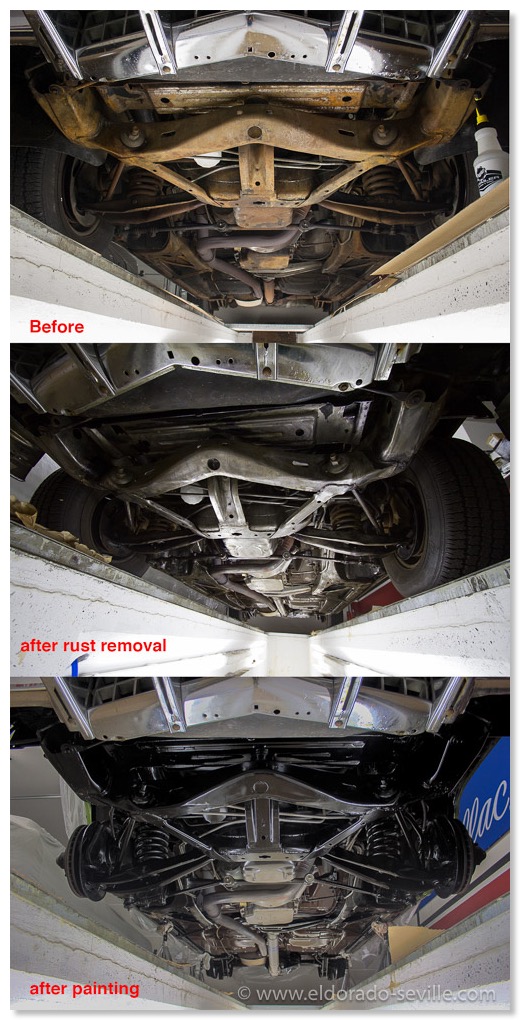
The various stages of this project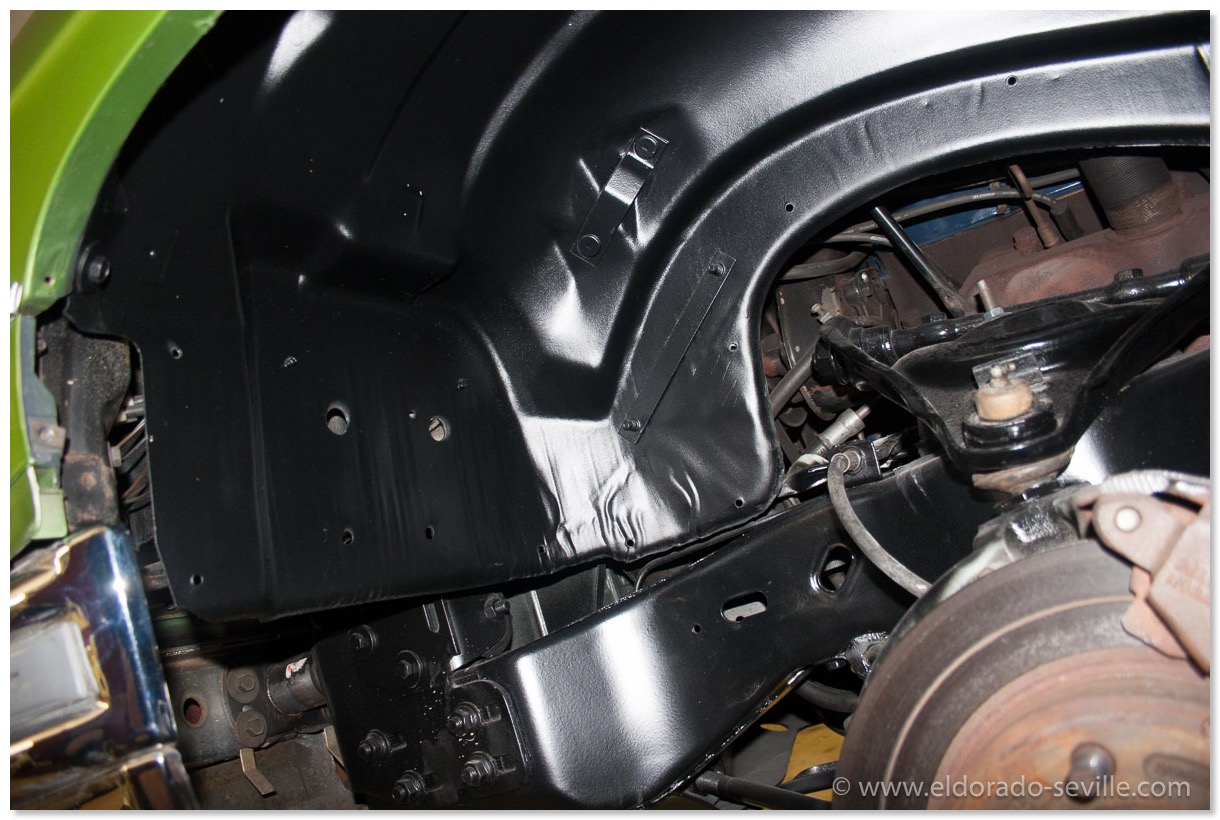
The re-painted wheelhousings. There are a few coats of "Timemax transparent undercoating" and "Timemax Body transparent" - a stone guard applied to protect the paint underneath.This stuff is great and also almost invisible.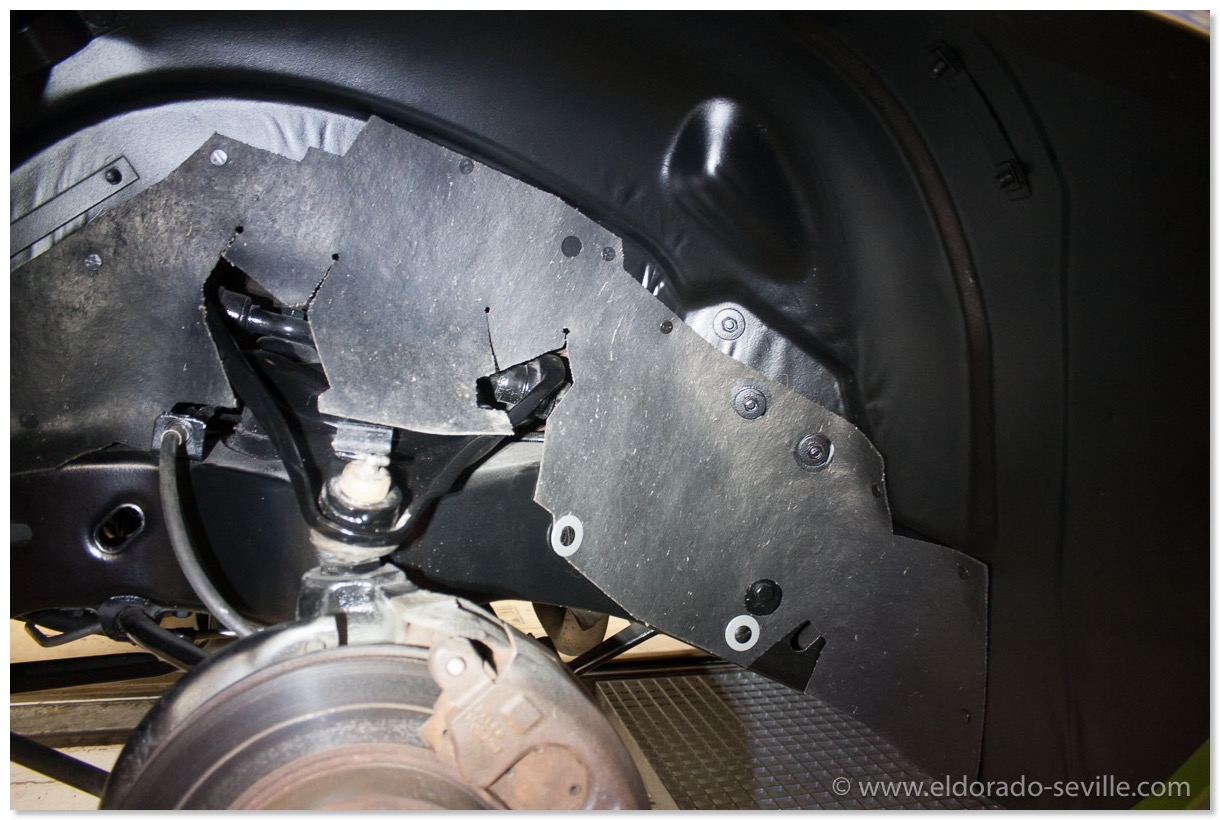
The re-painted wheelhousings. There are a few coats of "Timemax transparent undercoating" and "Timemax Body transparent" - a stone guard applied to protect the paint underneath.This stuff is great and also almost invisible. You can also see the detailed splash guards back in place.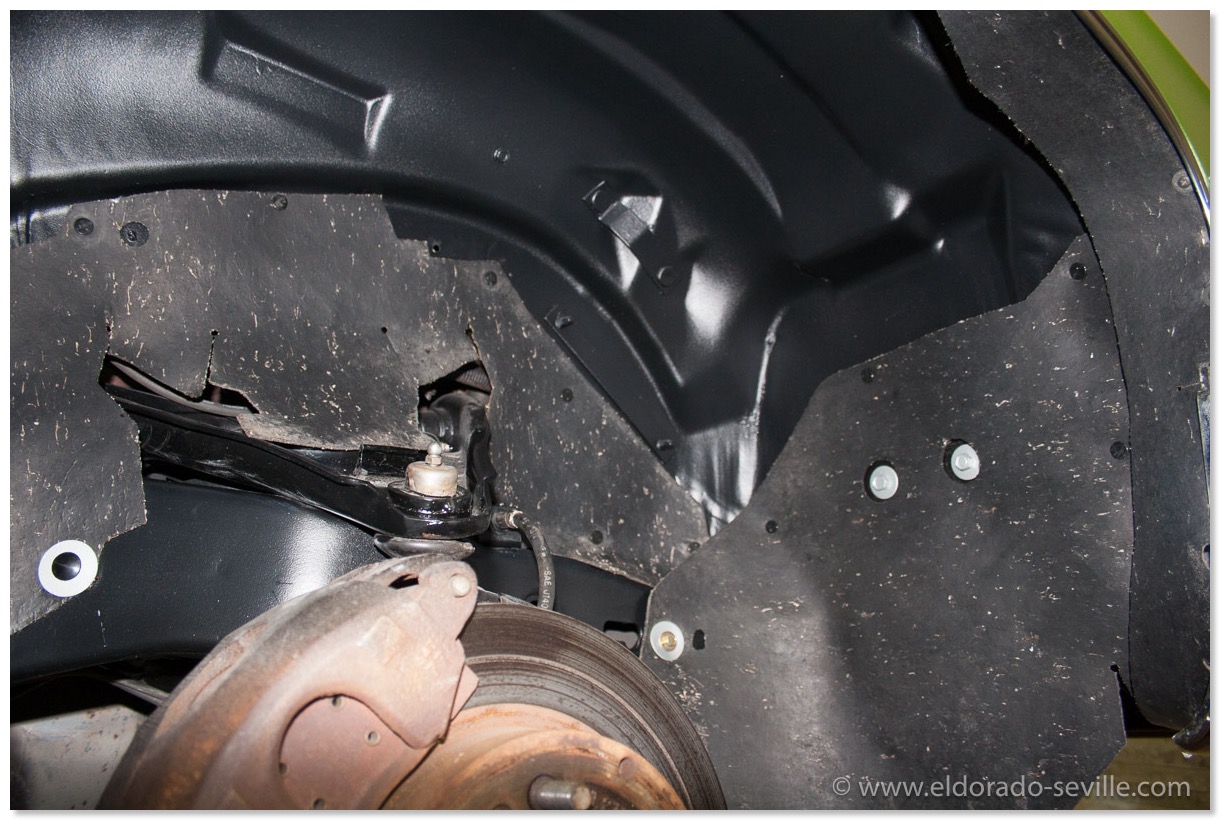
The re-painted wheelhousings. There are a few coats of "Timemax transparent undercoating" and "Timemax Body transparent" - a stone guard applied to protect the paint underneath.This stuff is great and also almost invisible. You can also see the detailed splash guards back in place.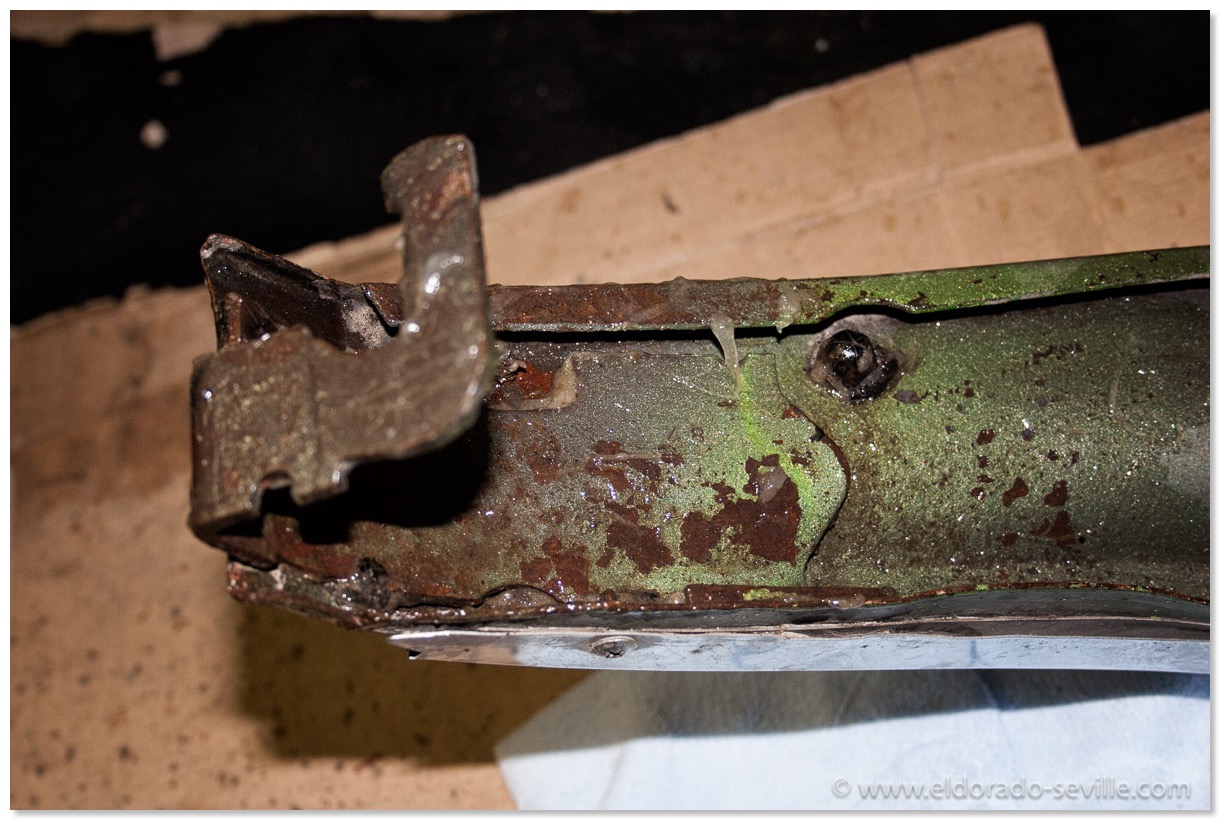
I removed all the rust inside the fender skirts as well and painted them afterwards to protect them. I also undercoated them with transparent undercoating as well.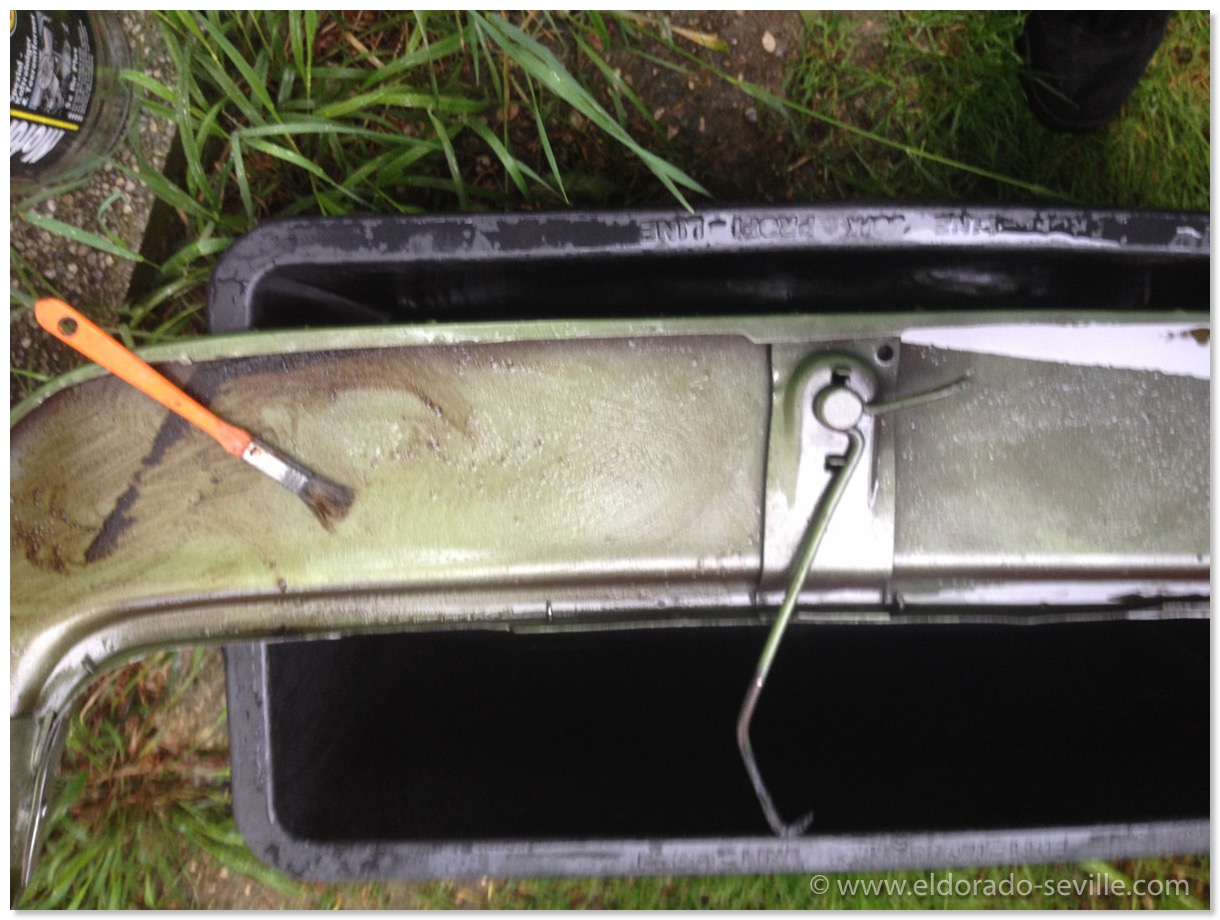
I used tar remover to clean the inside of the fender skirts which still had some factory applied undercoating on them.
This is how the rest of the underside of my 74 is looking now. I painted everything in the correct colors and protected it with transparent undercoating afterwards.
RESTORING THE 1974 CADILLAC´S WHEEL HOUSINGS ONCE AGAIN
I have already been so close to the finish line...
😭
I have no idea how to finish this project now, I will most probably have the 4 wheel housings done again by a professional restoration shop eventually. The rest of the undercarriage is finished and looks fantastic. I used the correct colors and replicated the factory new look.

The finished undercarriage - I applied some transparent undercoating over the freshly painted underbody which is completely invisible. This is some great stuff!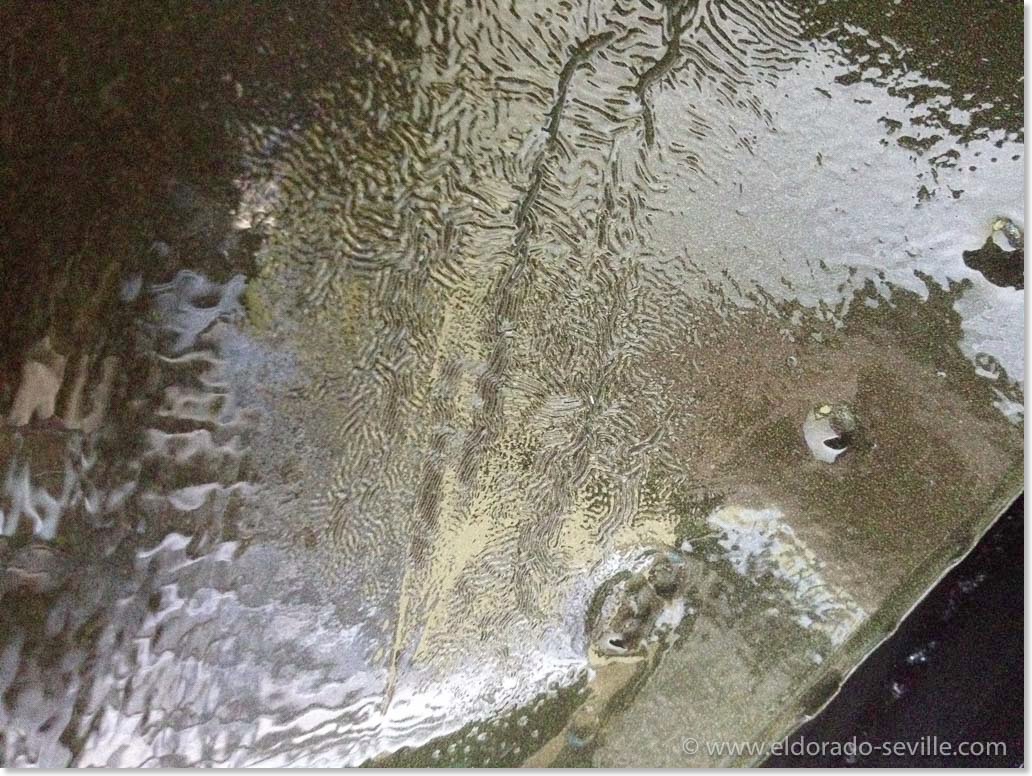
The transparent stone guard reacted with the paint... Now it's peeling off...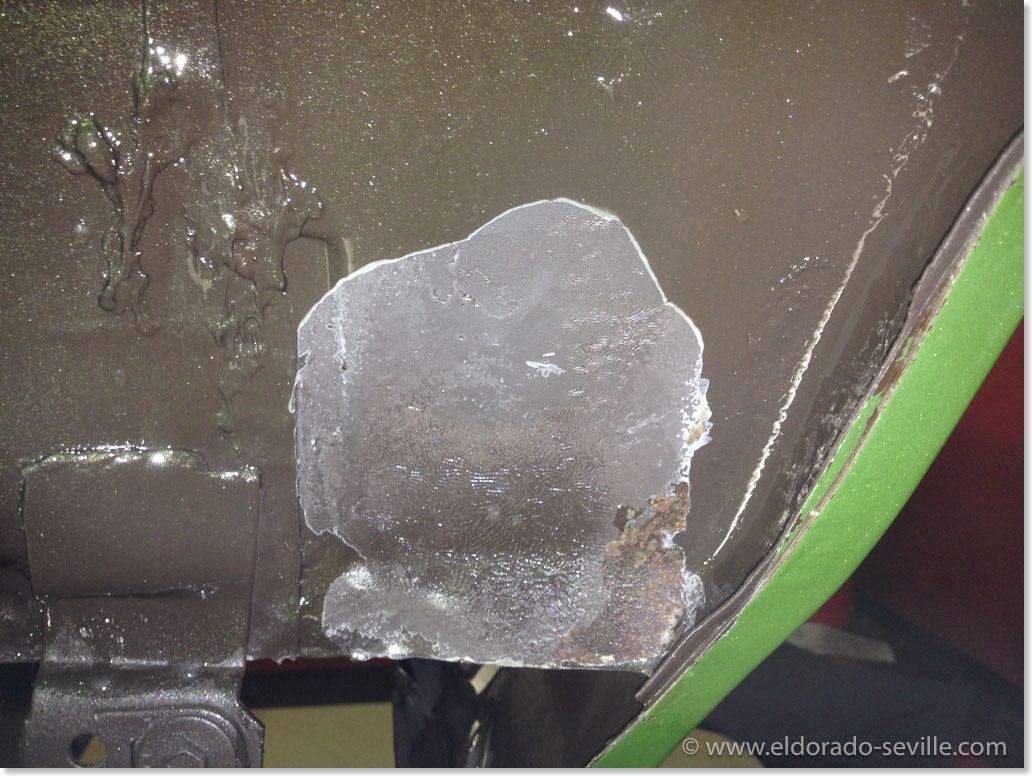
The transparent stone guard reacted with the paint... Now its peeling off...
DRY ICE BLASTING THE UNDERCARRIAGE OF THE 1974 CADILLAC
As I want to do it as perfectly as possible, I wanted to remove all the undercoating which was applied when the car was new.
I do not like rubberized undercoating, as you cannot see whats going on underneath. It can trap moisture and once it flakes off due to corrosion, there is already some major damage in the metal underneath.
There are different methods for removing the undercoating and most of the methods are a pain in the a**.
This stuff can be removed with a scraper and chemicals, or with heat and a scraper. Both methods will damage the metal underneath and scratch the paint on the underbody, and it takes forever…
As I did not want to use any of the methods mentioned above, I decided that I wanted to try dry ice blasting.
Dry ice-blasting is a form of carbon dioxide cleaning, where dry ice, the solid form of carbon dioxide, is accelerated in a pressurized air stream and directed at a surface in order to clean it. An alternative media for non-abrasive blasting is water-ice, known as ice blasting.
The method is similar to other forms of abrasive blasting such as sand blasting, plastic bead blasting, or soda blasting but substitutes dry ice as the blasting medium. Dry-ice blasting leaves no chemical residue as dry ice sublimates at room temperature.
Dry-ice blasting involves propelling pellets at extremely high speeds. The actual dry-ice pellets are quite soft, and much less dense than other media used in blast-cleaning (i.e. sand or plastic pellets). Upon impact, the pellet sublimates almost immediately, transferring minimal kinetic energy to the surface on impact and producing minimal abrasion. The sublimation process absorbs a large volume of heat from the surface, producing shear stresses due to thermal shock. This is assumed to improve cleaning as the top layer of dirt or contaminant is expected to transfer more heat than the underlying substrate and flake off more easily. The efficiency and effectiveness of this process depends on the thermal conductivity of the substrate and contaminant. The rapid change in state from solid to gas also causes microscopic shock waves, which are also thought to assist in removing the contaminant.
Unlike abrasive media blasting you cannot remove rust with dry ice blasting.
I found a company through the website of a classic car club, which is only a little over an hour away. I wanted to have it done before the first snow and as soon as possible, so that I could continue working on my car during the winter. The owner of the company did a great job. He is a very friendly and competent gentleman and it was a pleasure working with him.
Here is a short video how it was done: (make sure to watch in HD for proper image quality)
You can find all the pictures I took today in my restoration album.
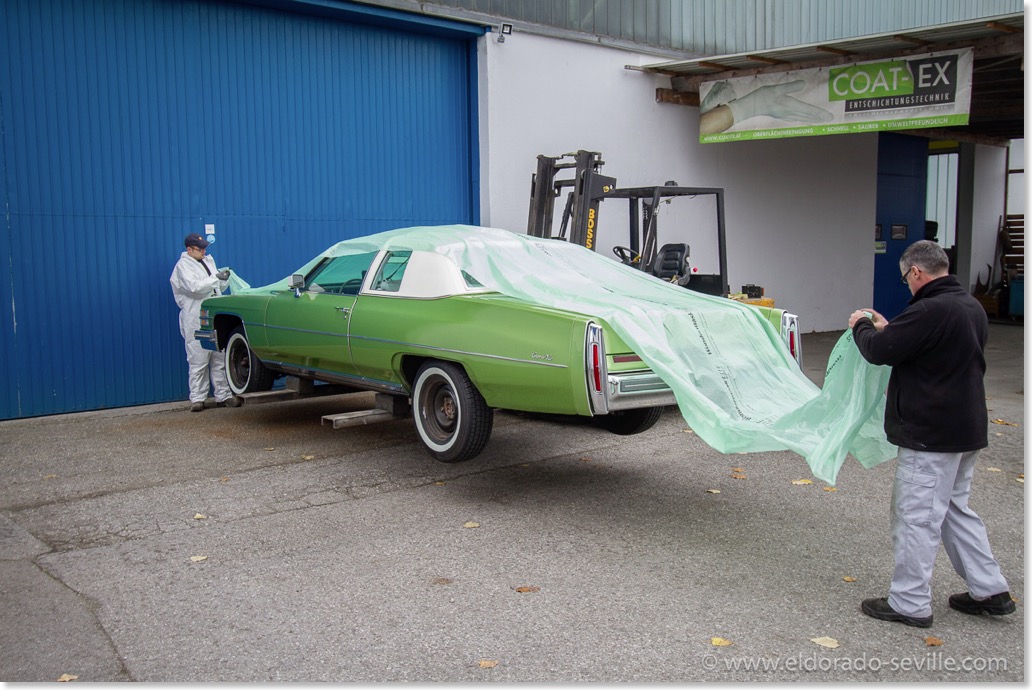
The car was lifted with a forklift and then covered in plastic.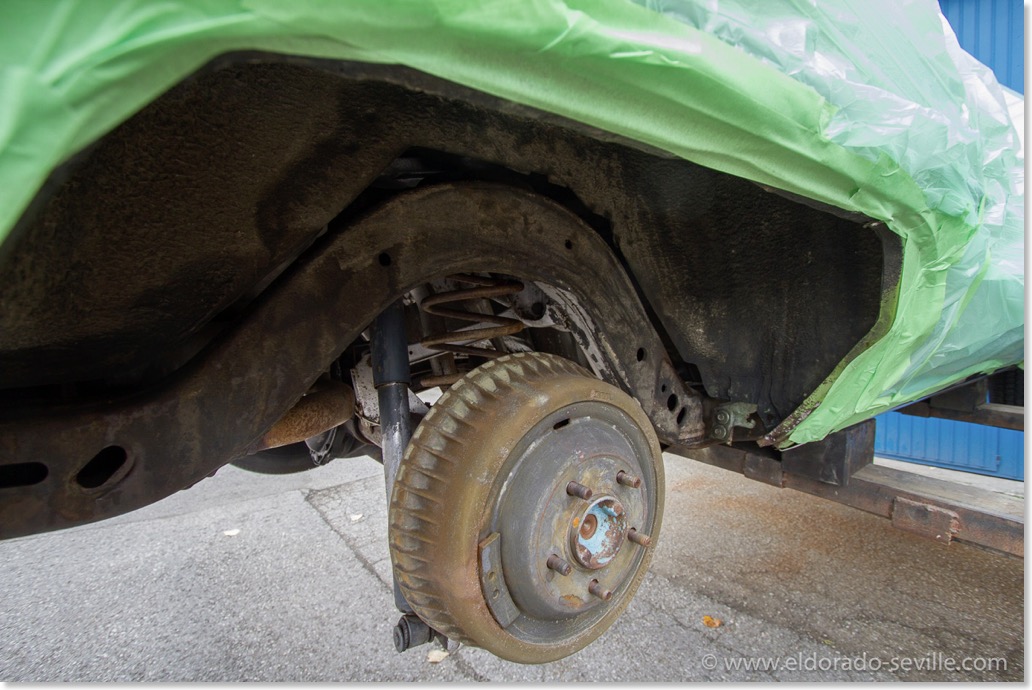
One of the rear wheel-housings before blasting - you can see the undercoating everywhere. 
The same wheel housing after blasting - all the original paint was still very well preserved under the undercoating. As you can see originally the wheel housing was brown. During painting a lot of overspray from the body landed in the wheel housing. Then Cadillac added rubberized undercoating to protect the metal from stone chips and to keep the car more quiet. Luckily there is no rust to be found anywhere.
During blasting.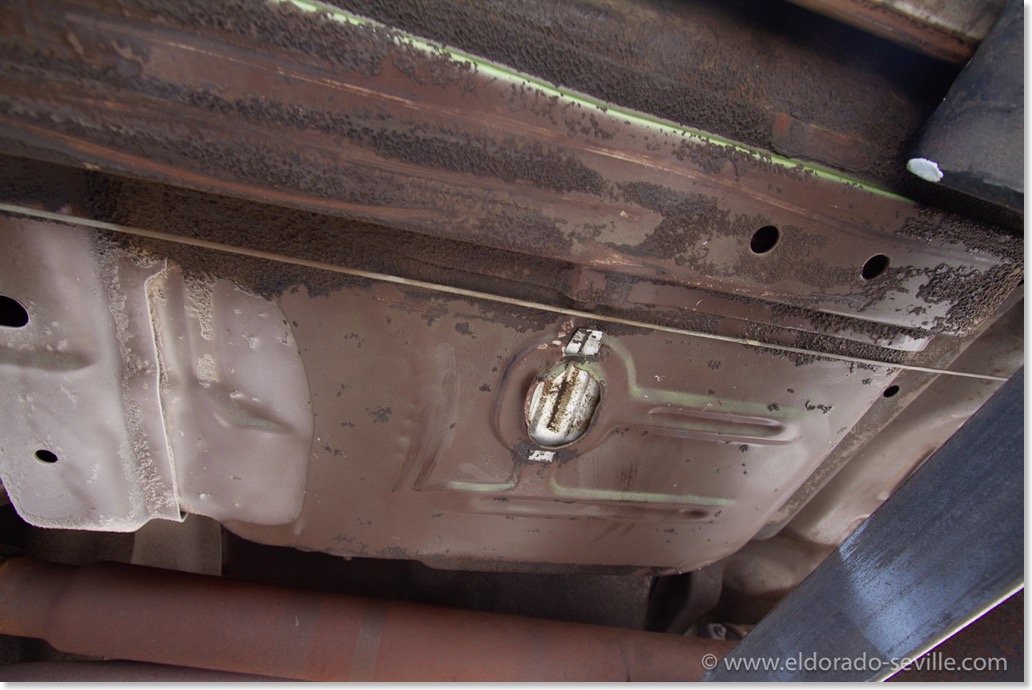
The original brown paint showed up underneath the undercoating. The paint is still in perfect condition. 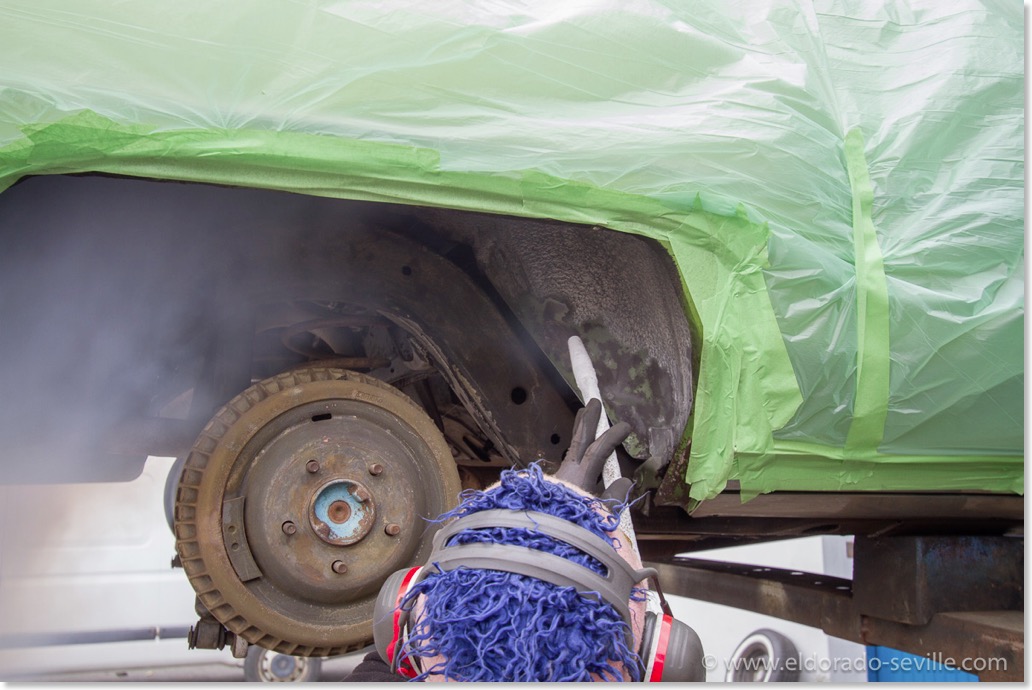
The original paint showed up underneath the undercoating in the wheel housings as well.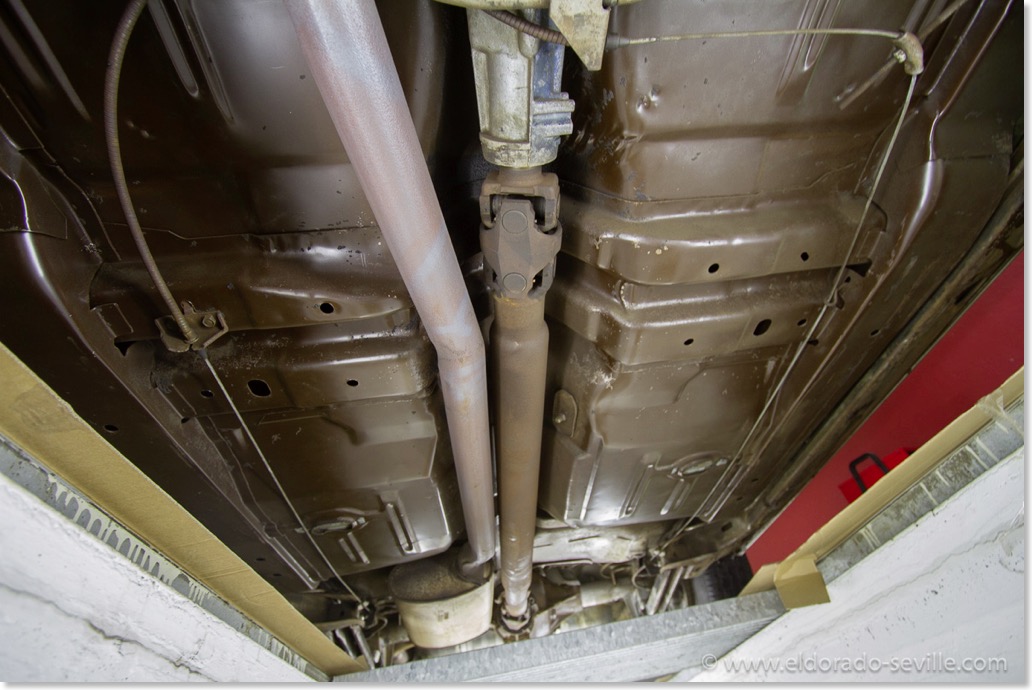
After cleaning - it came out really nice! I will touch up some areas and conserve the others with a special transparent coating.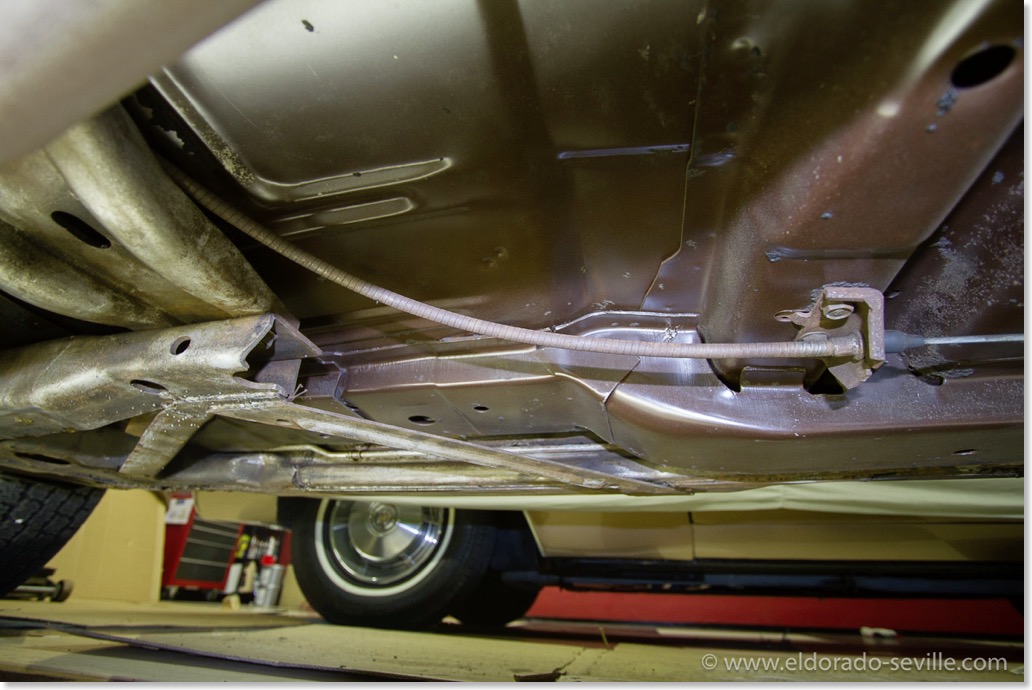
I´m very happy with the result of the cleaning and will now have to protect everything and paint some areas.
1966 Cadillac Coupe deVille (15)
1967 Cadillac DeVille (54)
1967 Cadillac Eldorado (71)
1971 Lincoln Continental Mark III (23)
1974 Cadillac Coupe deVille (45)
1978 Cadillac Eldorado Biarritz (24)
1996 Buick Roadmaster (19)
Car Shows (53)
Cruising (4)
For Sale (3)
Garage Stuff (32)
Pacer (1)
Restoration (137)
Various (55)
Video (16)
Website News (30)
- 6 way power seat
- 8-track
- 10 Ohm
- 429
- 1932
- 1957
- 1958
- 1958 Cadillac Eldorado Seville
- 1958 Cadillac Repair Tip
- 1959 Cadillac Eldorado Seville
- 1964
- 1965
- 1966
- 1966 Cadillac Coupe deVille
- 1966 Cadillac Repair Tips
- 1967
- 1967 Cadillac DeVille
- 1967 Cadillac Eldorado Repair Tip
- 1967 Cadillac Repair Tip
- 1967 Eldorado
- 1968
- 1970 Cadillac Eldorado
- 1971
- 1971 Lincoln Continental Mark III
- 1974
- 1974 Cadillac Coupe DeVille
- 1974 Cadillac Repair Tip
- 1976
- 1977
- 1978
- 1978 Cadillac Eldorado Biarritz
- 1978 Cadillac Repair Tip
- 1980 Cadillac Eldorado Biarritz
- 1996
- 2012
- 2014
- 2017
- 2018
- 2019
- 2022
- 2023
- 3063206
- 7027235
- 7800483
- 7805675
- 7805676
- 12355706
- 17058531
- 17059968
- 17059969
- 22010515
- 22010661
- A.I.R
- A6
- AC
- AC Compressor
- AC Electrical Diagram
- ACC
- Accelerator Pump
- Accelorator pump
- Actuators
- Adriatic Blue Metallic
- Ads
- Aftermovie
- Air Pump
- Aircondition
- AIRPUMP
- ALC
- Alternator
- AM
- AM-Transmitter
- Antenna
- Anti Rattle Clips
- Antique Gold
- Arizona Vintage Parts
- Arrival
- Article
- ASC
- Ash Tray removal
- ATC
- Atlantis Blue Firemist
- Austria
- Austro Classic
- Autolite SP-459
- Automatic Seat Back Release
- Award
- Banner
- Barn Find
- Battery
- Battery Tray
- Beach Race
- Bearing
- Bendix
- Biarritz
- Bigfoot
- Bill Hirsch Engine Enamel
- Bleeder Screws
- Blower
- Bolts
- Borg
- Brake Booster
- Brake Fluid
- Brake Gray
- Brakes
- Broken Bolt
- Brougham
- Bucket seats
- Buick
- Bumper End
- Bushings
- Cadillac
- Cadillac BIG Meet
- Cadillac BIG Meet
- Cadillac birthday cake
- Cadillac Blue
- Cadillac Color Selections Dealer Book
- Cadillac Coupe deVille
- Cadillac Dealer
- Cadillac Meeting
- Cadillac Mini Meeting
- Camaro RS
- Caorle
- Car Show
- Carburetor
- Card
- Carpet
- Carter AFB
- Cavalry Twill Vinyl
- CB
- CBM
- CCCD
- Choke
- Christmas
- Citizens Band
- Classic Cadillac Club Deutschland
- Clay Towel
- Cleaning
- Clock
- Clockwork
- Clutch
- Clutch Coil
- Collector
- Colonial Yellow
- Color Coded Springs
- Commercial
- Compound
- Compressor
- Condenser
- Continental Mark III
- Control Head
- Conversion
- Convertible top
- Coolant
- Corona
- Cowl
- Cruise Control
- Cruising
- CV Boots
- CV JOINTS
- D6230
- Dash Trim
- Decal Removal
- Decals
- Decoration
- Dehumidifier
- Delco Moraine
- Der Standard
- detailing
- Deville
- Diagnosis Chart
- Diagram
- Dial
- Digital Rotary Drum Clock
- Diner
- Disc Brakes
- Distributor
- Diverter Valve
- Door Jamb Switch
- Door Rubber Conduit
- Dornbirn
- Dot3
- Drive Shaft
- Driving tour
- Drum brakes
- Dry Ice Blasting
- Dry Ice Cleaning
- DVD
- Eastwood
- Eldorado
- Electric Choke Thermostat
- Electrical schematic
- Elvis
- Engine Bay
- Ep
- Epoxy floor
- Europe
- Evaporator
- Exide
- Factory Markings
- Fender Skirt
- Floor
- Flushing
- Foam
- For Sale
- Front AXLE
- Front brakes
- Front bumper filler
- Front Floor
- Front wheel bearing
- Fuel Filter
- Fuel Pump
- Fuel Sending Unit
- Fusible Link
- Garage
- Garage Cabinets
- Gasket
- GE
- Gear indicator
- General Time
- Glove box light
- Grand European
- H4
- Haus of Hot Rod
- Headlight Actuator
- Headlight doors
- Headlights
- Heater Core
- Heater Hose
- Heater Valve
- High Idle
- Holley
- Honest John
- Hood
- Hood Emblem
- Hood Ornament
- Hose Clamp
- Hot Choke
- Hot Water Valve
- HotRod
- How to
- Hödlmayr
- Ignition Diagram
- Illuminated Entry
- John D‘Agostino
- John Foust
- Klassikwelt Bodensee
- Kremsmünster
- LaSalle
- Leather seats
- Light Switch
- Limited
- Lincoln
- Lincoln Mark III Repair Tip
- Low Mileage
- Magazine
- Marilyn Monroe
- Mark III
- Master Cylinder
- Master Switch
- Master Vacuum Switch
- Media Blasting
- Meeting
- Meguiras
- MK II
- Mobile
- Model
- Moldings
- Mom
- Mopar Nationals
- Mostkost Kustom
- Movie
- Neon
- NOS
- Oberösterreicher des Tages
- oilchange
- ORF
- Overspray
- Pacer
- Paint
- Paint correction
- Paintjob
- Part Number
- Parts
- Patch Panel
- Perfect Circle
- Permabag
- Persian Lime
- Photo shooting
- Photoshooting
- Pictures
- PinUp
- POA Valve
- Power Antenna
- Power Servo
- Power Vent Windows
- Power Window
- Printed Circuit Board
- Programmer
- Pulley
- Quadrajet
- Quarter Panel
- Quartz Conversion
- R134
- Radiator
- Radio
- Rattle
- Rear brakes
- Rebuild
- Recalibrate
- RediRad
- Reed Switch
- Relais
- Relaunch
- Removing Overspray
- Repaint
- Repair
- Restoration
- RIP
- Roadhouse
- Roadmaster
- Rochester
- Rocker Arm Cover
- Rocker Panel Extension Clips
- Rostio
- Rotary Valve
- Rotterdam
- Rupes
- Rust removal
- Rust removal gel
- Sabre Wheels
- Sand Blasting
- Sandblasting
- Screed
- Season Greetings
- Seasons Greetings
- Seat Back Locks
- Seat Padding
- Seat Transmission
- See through ornament
- Self adjusters
- Sepp's Garage
- Seville
- Sheetmetal
- Shocks
- shop manual
- short
- Sign
- Solenoid
- Spark Plug Wire Routing
- Speakers
- Special Award
- Speed Bleeder Screws
- Splash Guard
- Starter Diagram
- Starter Motor
- Steering Column
- Storage
- suction throttling valve
- sunroof
- suspension
- Swirl Mark removal
- Switzerland
- T3
- Taillight Cover
- Texan´s Choice Award
- Thermostat
- Tilt and Telescope
- Time capsule
- Tomsclub
- Torque Specifications
- Tower Hose Clamp
- Towtruck
- Transducer
- Transmission
- transmission control selector
- transmission control selector indicator light
- transmission shift indicator
- Treadle Vac
- Treffen
- Tri-Band
- Troubleshooting
- Trunk Cardboard Kit
- Trunk lining
- Trunk to bumper cover
- Turn Signal Switch
- TV
- Typisierung
- Ultimate Garage
- Underbody
- Undercarriage
- Undercoating
- Undercoating Removal
- Vacuum Booster
- Vacuum diagram
- Vacuum hoses
- Vacuum Master Switch
- Vacuum Schematic
- Vacuum Valve
- Valve Cover
- Various
- Vent Window Switch
- Vibration
- Vibrator
- Vicodec roof
- Video
- Vinegar
- Vinyl Roof
- Visitor
- Washer Fluid Float
- Washer Fluid Low Level Indicator
- Water Pump
- Wax
- Weatherstripping
- Website News
- Westclox
- Wheel Bearings
- Wheel Housing
- Wiesbaden
- Windlace
- Winter
- Wiring
- Wiring Diagram
- Wonderbar
- Workbench
- Zurzach
 GERALD´S CADILLACS - NEWS
GERALD´S CADILLACS - NEWS
